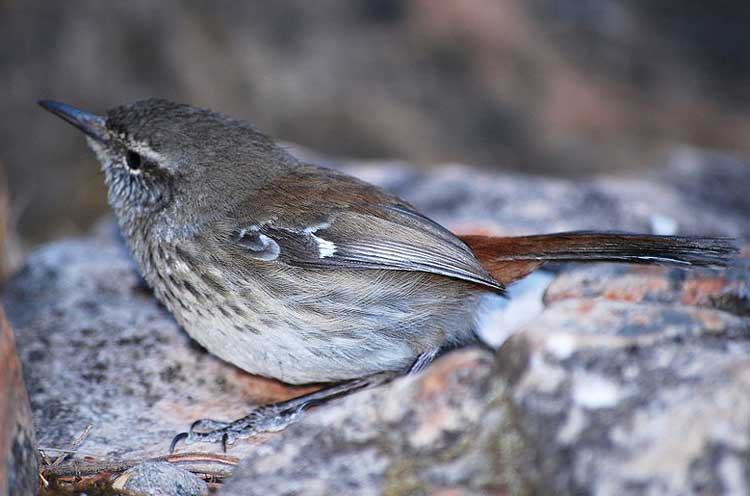Hylacola cautus (*) Cladus: Eukaryota Name Hylacola cautus Gould, 1843 Synonyms * Hylacola cauta
Reference Proceedings of the Zoological Society of London (1842) Pt10 no.117 p.135 The Shy Heathwren (Hylacola cauta) is a species of small bird in the Acanthizidae family, endemic to Australia. They inhabit mostly mallee woodland that has relatively dense shrub and heath understorey. Shy Heathwrens feed mostly on ground dwelling insects; rarely on seeds. Their ground level nests are dome-shaped and usually concealed within grass tussocks or shrubs.[1] Within the nest they typically lay 2-3 freckled and pinkish eggs.[2] The birds are cock-tailed bird with a chestnut rump that darkens towards the tip. Their feathers are white with brown streaking underneath and greyish-brown on the back and crown. They have a white eyebrow, tail tip and patch on the flight feathers and a black bill. Their eyes are brown to yellowish-brown and legs are slate-brown. Females have slightly duller colouring, and immature birds duller again with some of these being fawn coloured underneath.[2][3] They are uncommon residents across a wide part of Australia. Ranging from near West Wyalong in New South Wales to the Murchison River in Western Australia.[2] In New South Wales they are found in two isolated populations - one between Leeton, Willandra, New South Wales, Nymagee and West Wyalong, and the other from Balranald to Trentham Cliffs. Within the state they are seen as a threatened and vulnerable species, largely due to human wrought habitat loss and predation by foxes and cats.[1] Their taxonomic name was formerly Calamanthus cautus—classing them as fieldwrens— until they were renamed in 2008.[4] Notes 1. ^ a b "Shy Heathwren - Profile". Department of Environment and Climate Change, NSW. http://www.threatenedspecies.environment.nsw.gov.au/tsprofile/profile.aspx?id=10125. Retrieved 2008-06-05.
* BirdLife International 2004. Hylacola cauta. 2006 IUCN Red List of Threatened Species. Downloaded on 26 July 2007. Source: Wikipedia, Wikispecies: All text is available under the terms of the GNU Free Documentation License |
|

